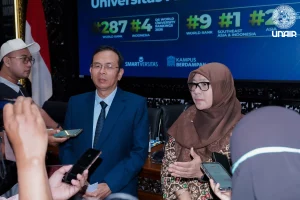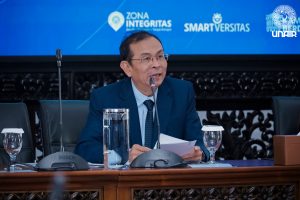UNAIR NEWS – Dr. Emy Koestanti Sabdoningrum, a Faculty of Veterinary Medicine lecturer at Universitas Airlangga (UNAIR), gave farmers in Sidoarjo training on livestock feed. The Livestock Feed Production Training event was held on Tuesday, May 2, 2023, in Modong Village, Tulangan District, Sidoarjo Regency.
A farmer of Panji Farm, drh Suharsana, also became a speaker. The event was attended by the Head of the Sidoarjo Regency’s Food Crops and Agriculture, the Head of the Livestock Production, Animal Health and Public Veterinary Health, the village officials, and related departments. The training, attended by 30 goat and sheep farmers, was conducted to optimise the region’s livestock farming.
“In this region, many people choose to become livestock farmers, especially goats and sheep. However, there are still many who do not have knowledge on feed, for example, how to process livestock feed,” said Emy.
In her presentation, Emy presented how to make Urea Molasses Block (UMB). UMB is an additional feed or supplement for ruminant livestock. UMB is solid and contains nutrients such as protein, minerals, and vitamins that can stimulate rumen microbial growth.
“UMB contains easily degradable protein and fermentable energy for ruminant animals,” she concluded.

The benefits of UMB
He added that UMB can provide measurable benefits for livestock, such as increasing the digestibility of low-quality feed, feed intake, and milk production and growth rate.
“UMB will increase the number of rumen or stomach microorganisms, so the need for roughage that is useful for their living media will also increase. From that, it will stimulate animals to eat more,” he added.
Emy also discussed the complete feed for livestock. According to her, animals must be given sufficient and complete nutrition to improve their productivity. The complete feed consists of a combination of several types of feed, such as forage feed, protein source feed, fiber source feed, mineral source feed, and supplement feed.
Complete feed also fattens the animals. Of course, it must contain several important components, such as crude protein at 14 to 16 percent, maximum crude fiber at 18 percent, and maximum moisture content at 14 percent.
“The provision of complete feed usually requires feed adaptation at first so that the feeding portion should be gradually increased,” Emy explained.
Ultimately, she advised that farmers should also be able to make their animal feed. Moreover, the ingredients are easy to find in the market. Making their complete feed can reduce costs and potential for farmers as a new business.
“So farmers no longer need to search for grass daily because the complete feed has a relatively long shelf life,” she concluded.
Author: Afrizal Naufal Ghani
Editor: Nuri Hermawan









